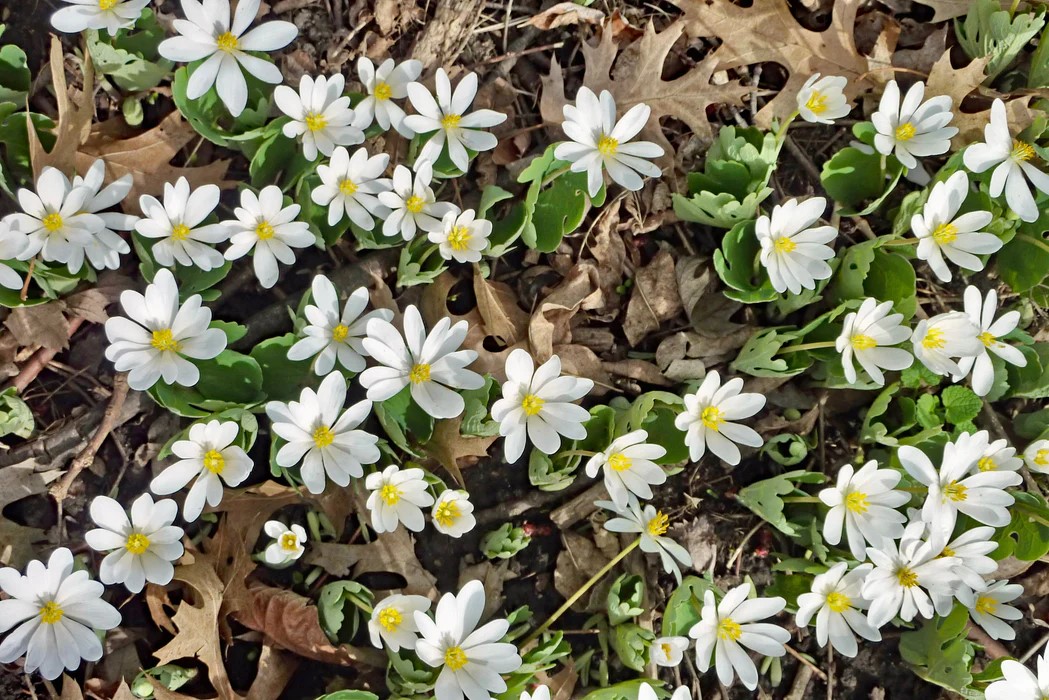Bloodroot (Sanguinaria canadensis) is a perennial, herbaceous flowering plant native to eastern North America, stretching from Nova Scotia in Canada to Florida in the United States. It belongs to the Papaveraceae family and is closely related to Eomecon species from eastern Asia. Interestingly, it’s the only species within its genus.
Common Names:
Bloodroot has gathered several traditional names over time, including:
-
Red Indian Paint
-
Red Root
-
Tetterwort
-
Red Puccoon
-
Paucon
-
Coon Root
-
Snakebite
-
Sweet Slumber
In Britain, "Tetterwort" usually refers to Greater Celandine.
Plant Description:
This small perennial plant features:
-
Kidney-shaped leaves with a greyish-green, downy surface and reticulated veining.
-
A single, slender, leafless flower stalk carrying a white, delicate, double flower.
-
A distinctive dark red rhizome (underground stem).
Bloodroot thrives in rich, open, deciduous forests across the eastern half of North America.
Parts Used:
-
Rhizome (underground stem)
-
Roots
Harvesting:
The plant’s rhizomes are typically collected:
-
Between May and June
-
Or during autumn, after the leaves have dried up.
Key Constituents:
Bloodroot’s medicinal power lies in its active compounds, including:
-
Isoquinoline alkaloids: sanguinarine, sanguidimerine, protopine, berberine, coptisine, chelerythrine, homochelidine
-
Red resin
-
Starch
-
Citric and malic acids
Therapeutic Uses & Pharmacology:
Traditionally, Bloodroot has served both medicinal and ritualistic purposes:
-
Respiratory Support: It’s widely used to treat respiratory conditions such as:
-
Bronchitis
-
Asthma
-
Croup
-
Laryngitis
Though an expectorant and emetic in high doses, it relaxes bronchial muscles, making breathing easier.
-
-
Circulation Booster: It stimulates sluggish peripheral circulation, especially in cold conditions.
-
Skin Conditions: Bloodroot preparations have been applied externally for:
-
Warts
-
Local infections
-
Inflammations
-
Some skin tumors
-
-
Dental Care: Its primary alkaloid, sanguinarine, is incorporated in some toothpastes and mouthwashes for its:
-
Antimicrobial
-
Anti-plaque
-
Possibly anti-cancer properties
-
-
Nasal Polyps: Historically, it was also powdered and inhaled (as a snuff) to shrink nasal growths.
Traditional Native American Uses:
American Indian tribes valued Bloodroot for its versatile healing properties, using it to manage:
-
Rheumatism
-
Asthma
-
Bronchitis
-
Lung diseases
-
Laryngitis
-
Fevers
-
Warts
It also held ceremonial significance as a dye and spiritual remedy.
Note:
While Bloodroot offers notable medicinal benefits, it should be used cautiously due to its potent alkaloids. High doses can cause nausea, vomiting, or toxicity. Always consult a qualified healthcare professional before use.
Speech Disorder
A speech disorder, also known as a speech impairment...
ADHD
Attention-deficit / hyperactivity disorder (ADHD) is a...
Cerebral Palsy(CP)
Cerebral palsy (CP) is a group of neurological disorders...
Cancer
Cancer is a broad term for diseases where cells...




